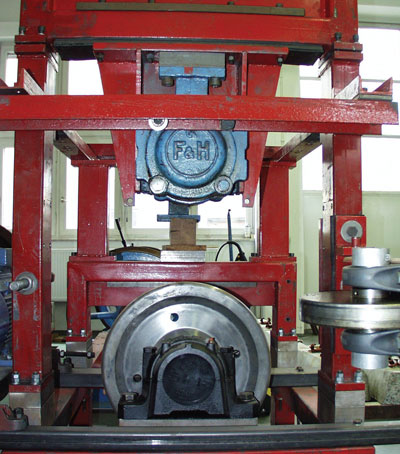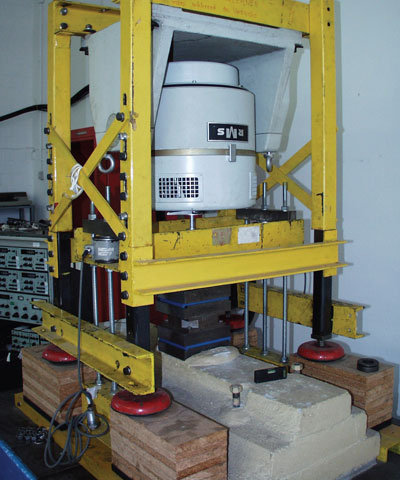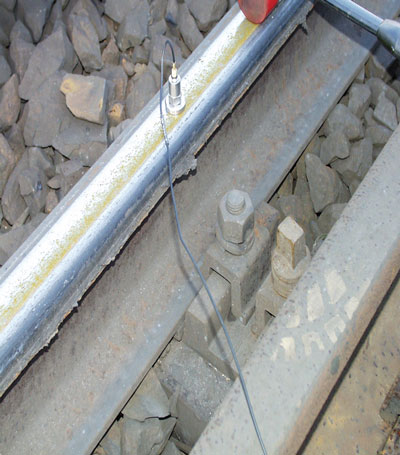LCC – an R&D project
Posted: 31 May 2005 | | No comments yet
Since 1997, the Department of Track and Railway Operations of the Technical University of Berlin has been led by Prof. Dr.-Ing. habil. Jürgen Siegmann, a distinguished expert in the field of railway operations who is frequently asked for his expertise by the industry. His department currently employs 13 assistants who are in charge of educating students as well as conducting research on topics concerning railways as a holistic system. The department also provides a railway control centre for educational purposes and a laboratory. On a regular basis tests for the industry are conducted in the certified test facility which is equipped with a universal test stand, a climatic chamber, several shakers and acoustic measurement equipment.
Since 1997, the Department of Track and Railway Operations of the Technical University of Berlin has been led by Prof. Dr.-Ing. habil. Jürgen Siegmann, a distinguished expert in the field of railway operations who is frequently asked for his expertise by the industry. His department currently employs 13 assistants who are in charge of educating students as well as conducting research on topics concerning railways as a holistic system. The department also provides a railway control centre for educational purposes and a laboratory. On a regular basis tests for the industry are conducted in the certified test facility which is equipped with a universal test stand, a climatic chamber, several shakers and acoustic measurement equipment.
Since 1997, the Department of Track and Railway Operations of the Technical University of Berlin has been led by Prof. Dr.-Ing. habil. Jürgen Siegmann, a distinguished expert in the field of railway operations who is frequently asked for his expertise by the industry.
His department currently employs 13 assistants who are in charge of educating students as well as conducting research on topics concerning railways as a holistic system. The department also provides a railway control centre for educational purposes and a laboratory. On a regular basis tests for the industry are conducted in the certified test facility which is equipped with a universal test stand, a climatic chamber, several shakers and acoustic measurement equipment.
Research and education of the railway system
It is common knowledge that probably the most important advantage of railways simultaneously causes significant problems: the low frictional resistance between wheel and track is a precondition of transport of heavy masses, high speed and an adequate input of energy, resulting in a relatively high degree of efficiency. On the other side it evokes:
- A long braking distance which requires external controlling
- High pressure between wheel and track and a high level of abrasion
- The requirement of automatic guidance and a wheel flange for the insurance of adequate safeness
- The constraint to link different tracks with movable components
The problems listed above play a central role in most of the research. Evolving from that, operational aspects like the arrangement of timetables, the management and commercialisation of tracks, train control systems, cost effectiveness of railways and the possibilities to reduce energy are scrutinised closer at the department. In comparison to rolling stock track and superstructure are issues that have been slightly neglected on the market throughout the past decades and have thus come to the fore as research topics.
The relevance of tracks and possibilities for optimisation
The railway track is long-living; however, construction and maintenance costs are high – a tribute to the complex control systems and safety philosophies. As a consequence preliminary objectives are to use track to full capacity and to ensure the availability for commercial use. Hence capabilities of cost reduction, especially in the field of construction as well as the increase of maintenance efficiency are in the focus of research.
In this context the assessment of new ideas and analyses can be supported by a tool developed at the institute, the Life-Cycle-Cost (LCC) model. It enables the user to overestimate all costs emerging from the complete product life cycle. Moreover, the influence of various ancillary conditions on the LCC, e.g. stress through operation, timetables, maintenance strategies, etc. can be displayed. Product life spans and times of maintenance actions are determined by the system. To give an example of the capabilities and the scope of the software it can be anticipated whether the construction of a new track with the utilisation of rigid rails and direct superstructure is – due to its lower maintenance costs – profitable on a long term view. Besides, incurring cost effects by rather infrequent or unlikely incidences can be integrated too. For instance, catastrophic scenarios such as train crashes or derailments; the consequences on various track systems and the emerging costs from removal, repair, overhaul or new construction, can be regarded.
On the other side some phenomena of tracks have not been clarified entirely: for example the extent of influence of ballast substructure on the settlement of the track, the cause-and-effect chain of short pitch corrugations, the effects of mats on substructure tensions, the long-term performance of elastic infrastructure components or elements, etc.
Research conducted at the laboratory
In the institute’s laboratory complete constructions such as ballast substructures, ballastless tracks, slab tracks and alternative solutions are analysed as well as components and materials.
Research was recently intensified on newly-designed infrastructure components, rail fastening systems, rail design, sound-absorbent roadbeds and elastic elements, e.g. layers and mats.
On a regular basis accompanying measurements are conducted on the operating system in order to validate the laboratory results.
Other research fields:
- Optimisation of elastic layers in between rails and sleepers, when regarding ballastless track mutual research and collaboration is carried out with the industry
- Tests and assessments for accreditation of innovative slab tracks
- Acoustic measurements with the objective of optimising sound-absorbent tracks
- Approaches and methods to minimise noise emission in narrow curve radii
- Practical acoustic measurements and analyses aiming at specific and adequate measures for noise reduction
- Endurance testing of elastic bearings and attenuation systems of tracks
- Acoustic tests on rail supaport systems
- Dynanometer fort testing and analysis of newly-designed wheel constructions
Methods for the reduction of infrastructure costs
The profitability of railways depends on costs for operation and infrastructure and the proceeds generated from the vending of transportation services. Due to high investments and long life cycles of railway infrastructure, the planning and decision-making process has to be considered thoroughly and – being the most cost-intensive factors – special attention must be paid to construction and maintenance.
Selection of current projects of the institute:
- LCC Analysis Tool
- Exploration of Alternative Infrastructure Systems
- Wear Behaviour of Tracks
- Optimisation of Maintenance Costs
- Development of bogies for freight cars that decrease stresses towards infrastructure
- Calculation Tools: Maintenance Complexities regarding the interaction between infrastructure and stresses/strains
LCC analysis tool
The importance of cost effectiveness in the railway sector increases steadily. This development was also the incentive to launch the LCC project, described below in more detail.
When establishing a new track infrastructure, costs amount to the total costs of the track with approximately 30 per cent. Nevertheless it has to be thoroughly considered which type of track system and construction is the most suitable for the future purposes. The latest development shows that ballastless track is almost exclusively used whenever tunnels and high speed lines are built. This sounds quite astonishing at first when considering that a running metre of installation of ballastless track is approximately twice as high as ballast track.
The advantages of ballastless track are a long-term durability of an estimated 60 years and an excellent long-lasting horizontal position in combination with little maintenance measures.
LCC models help to quantify and evaluate all facets and influencing factors on a monetary basis. However, LCC aspects sometimes play a minor role in decision-making processes and the attachment of more importance should be contemplated.
When considering service life of several decades the cumulative maintenance costs are often likely to exceed the construction costs of the track.
A further study deals with the question of which track system – regarding the complete product life cycle – is the most profitable when modernising regional lines? These tracks are mostly light railway ancillary lines that are rarely renovated or renewed in a complete and radical way. Hence the majority of infrastructure parameters still originate from the beginnings of the particular line routing, a period when the respective transportation was significantly different.
Therefore, it is inevitable to meet and maintain the requirements and standards of transportation companies without investing in track systems. For a more efficient operation it is furthermore necessary to maintain superior control systems, to modernise level crossings and to renew degenerated line sections.
Basically, the quality and representation of the LCC calculation is severely dependant on the quality of available data, e.g. the determination of service life, the accuracy of data concerning construction and maintenance costs, blocking times and the frequency of maintenance activities.
Few features of the LCC model are based on presumptions, e.g. cost effectiveness of different types of line routings or performance and damage behaviour of track elements. These influential aspects are compulsory for the calculation and efforts are made to be as representative as accomplishable, need for research in this connection is still obligatory.
Another profound problem of railways is the immense noise emission. When regarding freight haulage and in particular the coactions between rail vehicles and infrastructure, room for improvement can be constituted. There is a growing need for detailed case studies, the field testing of noise-absorbent elements and the analysis of innovative track systems, e.g. continuous rail support systems. One possible solution to avoid exceeding estimated costs is to lower the track fares for transportation companies utilising noise-absorbent equipment.
Challenges and outlook
One approach to cope with challenges of railway infrastructure is to handle the system in a holistic way.
The objective of the European Commission and national railways across Europe is to strive for the realisation of a more standardised railway system. There is always the possibility that companies take advantage of changes and boost prices, but the upcoming and expected release of new norms also offers potential to increase economies of scale and hence lower prices.
In times of continuously shortening life cycles new technologies are quickly replaced by even newer components. Therefore depreciation periods have to be consistent with effective operation periods.
It is a long way towards a unitary railway system and the sustained euphoria and the optimism, e.g. concerning TSIs, sometimes rather have to be dampened in this connection.


Figure 1: Test stand for wheel constructions


Figure 2: Shaker equipped with a telemetrical transfer system for measurement data


Figure 3: Acoustic measurements carried out on track







